John Janaro's Blog, page 277
May 15, 2014
How Can We Have True Compassion For Those Who Suffer?
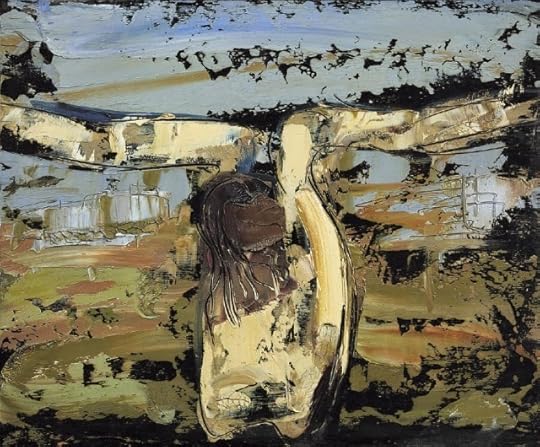 William Congden, Crucifixion seriesI'm not going to offer my own reflections on such a profound problem. Instead, I have a few striking selections (with notes from me, occasionally, in brackets [ ] ) from a book that is rich in what it offers to both the mind and the heart, by the great and unheralded theologian (and my old friend) Msgr. Lorenzo Albacete. The little book is called God at the Ritz (click the link and buy a copy). The title is both serious and funny, but I'm not going to explain that here. You'll have to get the book to find out.
William Congden, Crucifixion seriesI'm not going to offer my own reflections on such a profound problem. Instead, I have a few striking selections (with notes from me, occasionally, in brackets [ ] ) from a book that is rich in what it offers to both the mind and the heart, by the great and unheralded theologian (and my old friend) Msgr. Lorenzo Albacete. The little book is called God at the Ritz (click the link and buy a copy). The title is both serious and funny, but I'm not going to explain that here. You'll have to get the book to find out.These thoughts (selected from pp. 81-116) are worth going through, because I think Msgr. Albacete presents an understanding of compassion as "co-suffering" that is essential to how we can really help one another and stand together with one another in solidarity in suffering. This ingredient of "co-suffering," I think, is proper to every gesture of compassion including those that bring relief to the suffering of others.
It's something I want to ponder and develop further, personally as a human being and perhaps also philosophically/theologically. Note that the "audience" for these remarks is not just Christians but all people who search for meaning, who suffer and practice love and compassion:
What is human suffering? Suffering is not the same as pain. Pain is a symptom indicating that something is wrong at one or more of the three levels of human awareness: physical, psychological, and spiritual. [Note: there is an interesting discussion of this point, but the theme is that what distinguishes the core of specifically human suffering is the way it touches a person's identity, the way it introduces a rupture of the person's expectation of the "good-for-myself," or even the presumption of its realization. This rupture, experienced as "against-me," provokes—in the intrinsic reality of human personal suffering—a fundamental and vital question.]
Suffering occurs when you seek to understand the reason for pain—not the cause of it, but the reason for it—the "ultimate reason" if you will, for "why this should happen." We ask "why?" because suffering breaks our mental schema of how things should be. Suffering tears apart our worldview, our assumptions about life. We ask why in the face of inexplicable imperfection. Asking why drives us beyond our preconceived notions toward something more.
Often, without realizing it, we address our "why" to the Source of meaning. We look for a face that is ultimately responsible for everything. In essence, then, we aren't looking for explanations. We are looking for something else: we are looking for salvation, for redemption. When we suffer, asking "why" moves us toward transcendence.
[This question (why?) is in some way the distinctive form of the experience of human suffering. The question] surges out of the human heart and breaks through all attempts to suppress it. [And, it] opens us to others who are also suffering, thus creating a solidarity among those who suffer. To suffer together means to walk together toward transcendence.
This solidarity is the proper human response to [the] suffering [of others]. This doesn't mean that we "share the pain" of those who suffer. While this phrase is used quite often, I don't think this is possible. Nothing is more intimately personal than the pain of suffering. It is, after all, a wound in our personal identity, and personal identity cannot be shared. Each person is unique and unrepeatable. What we share is the questioning, and thus we suffer with the one who suffers. We "co-suffer" with that person.
The only adequate response when confronted with another person's suffering is co-suffering. It is the only way to respect the suffering of another. Co-suffering affirms the wounded personal identity of the sufferer through our willingness to expose our identity to the questioning provoked by the sufferer's pain. This willingness to share suffering is an act of love. Co-suffering is the way we love the one who suffers.
In our relationship with the one who suffers, we as co-sufferers can impose nothing on the other person. We can only help the other to ask the question "why" by asking it together—that is, by praying together. Praying together with the one who suffers is the just response to the suffering.
The redemption of suffering, as our experience indicates, cannot be found as an "ultimate answer" to a problem: it can only be an event that transforms the drama of suffering into a drama of love and shows love to be more powerful than its denial. The possibility of this event sustains a realistic hope and an unfailing determination to protect and defend human freedom and the dignity of human life.
Published on May 15, 2014 20:35
May 13, 2014
An Extraordinary Motherly Protection and Care
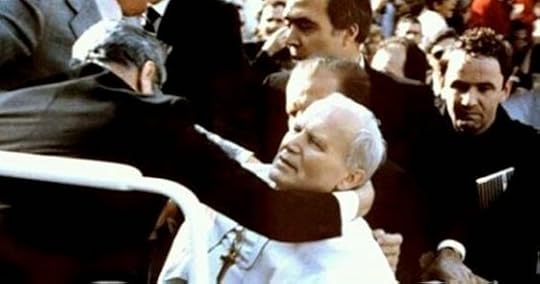 St John Paul II, moments after being shot on May 13, 1981May 13 commemorates two great interventions of the Mother of God in the twentieth century: Her appearance to the shepherd children at Fatima in 1917, and her intervention in St. Peter's Square in Rome to save a bishop in white from what should have been a fatal bullet in 1981.
St John Paul II, moments after being shot on May 13, 1981May 13 commemorates two great interventions of the Mother of God in the twentieth century: Her appearance to the shepherd children at Fatima in 1917, and her intervention in St. Peter's Square in Rome to save a bishop in white from what should have been a fatal bullet in 1981.Saint John Paul II confessed his faith with his blood on May 13, 1981, and the Virgin Mary saved him for the sake of the Church, and the world.
Thank you, Merciful Mother Mary! Thank you for preserving your devoted son who had entrusted everything to you, the bishop of Rome whose motto was "Totus Tuus." Thank you for making of him a great gift to all of us, as a voice in the night, a light in the midst of so much darkness.
Five months later, on October 7, 1981, the Feast of the Holy Rosary, he returned to St. Peter's Square and to his public audiences, where he said:
Again I have become indebted to the Blessed Virgin and to all the patron saints. Could I forget that the event in Saint Peter's Square took place on the day and at the hour when the first appearance of the Mother of Christ to the poor little peasants has been remembered for over sixty years at Fatima in Portugal? For in everything that happened to me on that very day, I felt that extraordinary motherly protection and care, which turned out to be stronger than the deadly bullet."Anyone who has lived from that day to this day should know that it's worth it to trust in that motherly protection and care, and to have confidence that Jesus is in charge of His Church, always. Pray the Rosary... and don't worry!
Published on May 13, 2014 20:30
May 12, 2014
All That Lies at Hand

O God, O Jesus, O vivifying Spirit:
Without You I can do nothing.
Without You,
every moment is a crushing burden;
every trial pricks and stings my tired flesh.
Without You,
I do nothing;
I am nothing;
I am a huge, hollow hole of nothing.
O Lord my God;
O Jesus, Redeemer and Healer;
O Holy Spirit—Lord and Giver of Life:
With You
I can do all
that lies at handin the small space of today.
With You,
I can endure whatever weight
You ask me to bear in this moment,trusting in Your wisdom and love.
--adapted from a passage in my book about the challenges of living with chronic debilitating illness: Never Give Up: My Life and God's Mercy (Published by Servant/Franciscan Media).
Published on May 12, 2014 18:30
May 8, 2014
Young People are Made for the True Richness of Life
 May blossoms in the morning.Last night I had a really beautiful discussion with John Paul and Agnese about the value of learning, of being educated as human persons, of experiencing the meaning of things in the context of truth, goodness, and beauty.
May blossoms in the morning.Last night I had a really beautiful discussion with John Paul and Agnese about the value of learning, of being educated as human persons, of experiencing the meaning of things in the context of truth, goodness, and beauty.They are already beginning to see these things in high school. (Chelsea Academy has been such a blessing.) But they certainly are old enough. They're opening up like blossoms in the morning of their lives, in the time when their adult personalities are taking shape. Certainly they're having lots of fun, but it's within the context of discovering the true richness of life.
These years from 15 or 16 years old on through college are so rich in the potential for growth, for laying the foundations of one's attitude for the whole of life. What a waste it is to throw these years away in superficial satisfactions. Young people are "wild" because the great upsurge of freedom within them tries to connect anything that is given to it with infinity.
And this society tries to enslave that wildness to individual and reciprocal indulgence; to behaviors, styles, and products that promise falsely to satisfy, but only lead to banality and then a new round of false promises. This society distorts the youthful thirst for life, and deflects it into a pattern of perpetual consumption and dissatisfaction. The result is that people grow bitter with age, but they never grow up.
Nevertheless, people keep buying stuff. There is a lot of money to be made off of perpetually misdirected and frustrated hopes. But it is an outrage to turn the sacred space of the human heart into a den of thieves!
Instead, why not cultivate an environment of true freedom for young people, for our kids? Why not point them in the direction of the more profound truth -- the ultimate truth -- that their mind's eye has begun to seek? These free spirits who continue to grow and surmount boundaries: they are drawn by the Infinite, the inexhaustible Mystery who makes them.
Can we not accompany them and guide them toward the decisive encounter of their lives? In so doing, we will rediscover our own youth.
Published on May 08, 2014 20:39
May 6, 2014
Wasting Time, Part II: How I Ended Up in Russia
And now I shall continue this rambling story, and you will find that it is not without interest.
I grabbed this book off my shelf yesterday and became absorbed by it, but, as I said, the Lord is merciful. It turned out to be a very interesting book about Saint Sergius and Russian Spirituality. Yes. Really! That book attracted my interest, and I started reading. I found it hard to stop reading. (I challenge anyone to a NERD contest, any time, any place... I will outnerd you!)
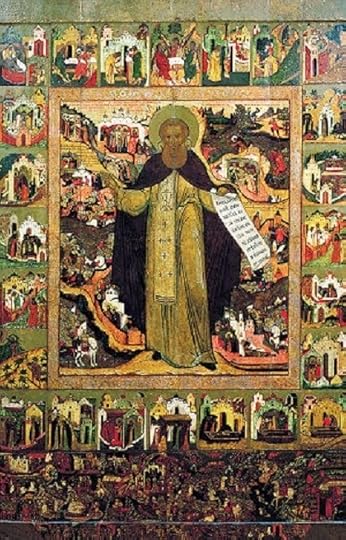 This icon has pretty much the whole story.But seriously: I already knew a lot of what was in this book, and I knew that is was great and deeply significant history, but present circumstances put it in a new perspective.
This icon has pretty much the whole story.But seriously: I already knew a lot of what was in this book, and I knew that is was great and deeply significant history, but present circumstances put it in a new perspective.
Sergius of Radonezh is a Russian Orthodox saint of the 14th century. He is one of the great saints of Russian monasticism who also played the role of peacemaker among the factions that were emerging as the Mongol grip was loosened in the north. St. Sergius is a national hero and symbol for Russia, although this is something of an accident of history. His monastery was near Moscow, and his counsel to the prince and his prayers are linked forever to the decisive Battle of Kulikovo in 1380, which was a "Lepanto-like" victory by Christian Slavs over the Mongols.
Stay with me here, because this matters. This is the birth of the Russia we know today. This Russia traces its origin to the great lost city of Kiev, which was a wonder of the 11th and 12th centuries and known well throughout Europe. Ancient Kiev was vaporized by the Golden Horde in 1240, and I mean really vaporized! The Mongols -- an inscrutable confederacy of nomads brought together by Genghis Khan -- were like a combination of an unstoppable force of nature and a ferocious weapon of mass destruction.
Ancient Kiev, the Kiev of St. Vladimir and the people of Rus, was basically nuked. The "Golden Horde" didn't need a bomb. They killed everyone. They burned everything. Then they pitched camp, chewed on dried mutton, rested, raced their horses, and headed for the next town.
They had a simple philosophy. A divine being ruled heaven, and they ruled earth. Their motives for being ruthless weren't very clear, but at some point they realized that if they came to a city and decided not to just toast it, there was a lot of money to be made.
The Christian Slavs who could fled, many to the north. Kiev was erased from the map. Part of the problem of tracing the Slavic heritage is this unparalleled event and its consequences. The Mongols swept over the world of medieval Rus, wiped part of it out and left the rest of it to pay tribute. This was terrorism. But it also became, over time, a migration and partial assimilation, with the "Tartars" settling and some even converting to Christianity. The khans were curious about religion, and even considered Christianity. In the end, however, they chose Islam.
Russia was born over a century later, inspired in part by a monk who was a man of peace, a monk who lived as a hermit and shared his bread with a bear every day, who founded a monastery under obedience to the bishop and served as abbot by building the cells of his novices and bringing them water and food, a monk who counseled peasants and princes, and who convinced princes not to fight with one another.
The Battle of Kulikovo was a matter of self defense. When it became clear that the Horde could not be stopped by tribute or even temporal humiliation, Sergius blessed Prince Dmitri and told him to go forth boldly, trust God, and prepare for death. Many did die on that day, but the Prince lived and prevailed. Muscovy and its princes became the unifying center of the Eastern Slavic world. Eventually they became Emperors with a stature beyond anything St. Sergius could have imagined in the 14th century.
Fascinating stuff. And, in fact, very much worth knowing and remembering.
In celestial glory, St. Sergius prays for peace between his brothers on earth today. May his prayers be heard.
I grabbed this book off my shelf yesterday and became absorbed by it, but, as I said, the Lord is merciful. It turned out to be a very interesting book about Saint Sergius and Russian Spirituality. Yes. Really! That book attracted my interest, and I started reading. I found it hard to stop reading. (I challenge anyone to a NERD contest, any time, any place... I will outnerd you!)
 This icon has pretty much the whole story.But seriously: I already knew a lot of what was in this book, and I knew that is was great and deeply significant history, but present circumstances put it in a new perspective.
This icon has pretty much the whole story.But seriously: I already knew a lot of what was in this book, and I knew that is was great and deeply significant history, but present circumstances put it in a new perspective.Sergius of Radonezh is a Russian Orthodox saint of the 14th century. He is one of the great saints of Russian monasticism who also played the role of peacemaker among the factions that were emerging as the Mongol grip was loosened in the north. St. Sergius is a national hero and symbol for Russia, although this is something of an accident of history. His monastery was near Moscow, and his counsel to the prince and his prayers are linked forever to the decisive Battle of Kulikovo in 1380, which was a "Lepanto-like" victory by Christian Slavs over the Mongols.
Stay with me here, because this matters. This is the birth of the Russia we know today. This Russia traces its origin to the great lost city of Kiev, which was a wonder of the 11th and 12th centuries and known well throughout Europe. Ancient Kiev was vaporized by the Golden Horde in 1240, and I mean really vaporized! The Mongols -- an inscrutable confederacy of nomads brought together by Genghis Khan -- were like a combination of an unstoppable force of nature and a ferocious weapon of mass destruction.
Ancient Kiev, the Kiev of St. Vladimir and the people of Rus, was basically nuked. The "Golden Horde" didn't need a bomb. They killed everyone. They burned everything. Then they pitched camp, chewed on dried mutton, rested, raced their horses, and headed for the next town.
They had a simple philosophy. A divine being ruled heaven, and they ruled earth. Their motives for being ruthless weren't very clear, but at some point they realized that if they came to a city and decided not to just toast it, there was a lot of money to be made.
The Christian Slavs who could fled, many to the north. Kiev was erased from the map. Part of the problem of tracing the Slavic heritage is this unparalleled event and its consequences. The Mongols swept over the world of medieval Rus, wiped part of it out and left the rest of it to pay tribute. This was terrorism. But it also became, over time, a migration and partial assimilation, with the "Tartars" settling and some even converting to Christianity. The khans were curious about religion, and even considered Christianity. In the end, however, they chose Islam.
Russia was born over a century later, inspired in part by a monk who was a man of peace, a monk who lived as a hermit and shared his bread with a bear every day, who founded a monastery under obedience to the bishop and served as abbot by building the cells of his novices and bringing them water and food, a monk who counseled peasants and princes, and who convinced princes not to fight with one another.
The Battle of Kulikovo was a matter of self defense. When it became clear that the Horde could not be stopped by tribute or even temporal humiliation, Sergius blessed Prince Dmitri and told him to go forth boldly, trust God, and prepare for death. Many did die on that day, but the Prince lived and prevailed. Muscovy and its princes became the unifying center of the Eastern Slavic world. Eventually they became Emperors with a stature beyond anything St. Sergius could have imagined in the 14th century.
Fascinating stuff. And, in fact, very much worth knowing and remembering.
In celestial glory, St. Sergius prays for peace between his brothers on earth today. May his prayers be heard.
Published on May 06, 2014 19:21
May 5, 2014
Wasting Time (Part I): The Allure of Old Media
Well, this day was basically a bust. I just couldn't make anything happen today. No words... even though I have to finish an article.
Let me look on the bright side. It was like this today:
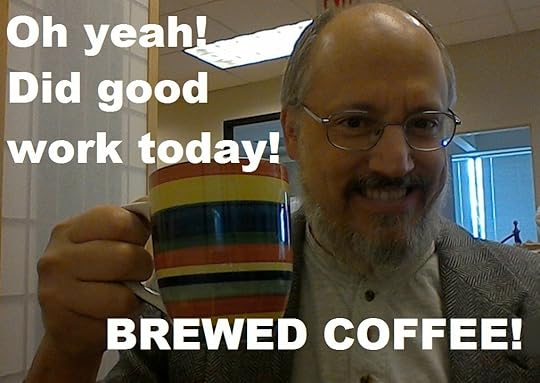
It was good coffee too.
Actually, I got totally diverted this morning, and the amazing thing is that this diversion WAS NOT CAUSED BY THE INTERNET! I cannot blame the Internet for sucking up my time today. It wasn't the Internet that Kept-Me-From-Smelling-the-Flowers-and-Watching-the-Sunset-and-Looking-Deeply-Into-the-Eyes-of-Those-I-Love....
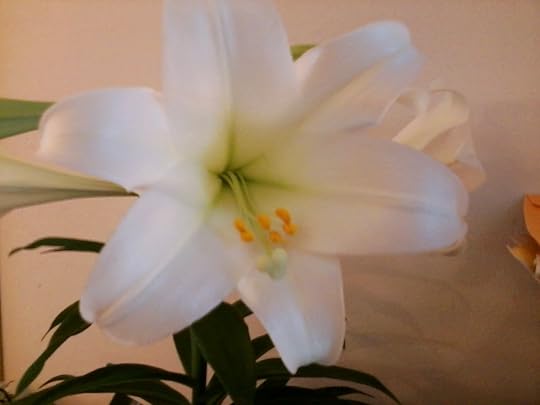 Easter lilies don't last long: smell them while you can!
Easter lilies don't last long: smell them while you can!
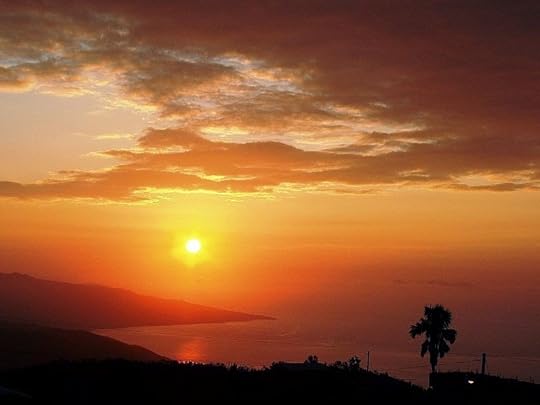 I should have been online. I could have watched the sunset in Jamaica!
I should have been online. I could have watched the sunset in Jamaica!
 As for "the eyes of my loved ones," well... this is just NORMAL around here.
As for "the eyes of my loved ones," well... this is just NORMAL around here.
Nope. Don't blame Zuckerberg for today. Blame Gutenberg.
Books.
Long before the Internet was born, I had already developed the talent of "book-surfing." I didn't call it that, of course. I used the technical term for it: research!
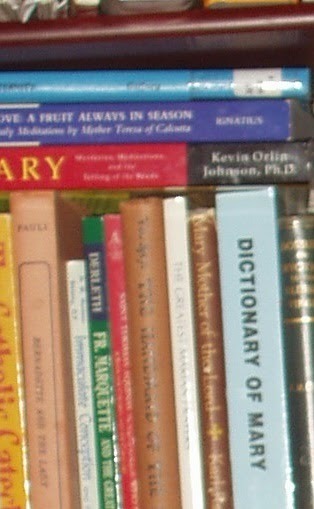 Not these books. Another shelf.All joking aside, surfing the bookshelf is not the most efficient way of acquiring or deepening one's understanding. One of these days I shall blog seriously about a genuine problem, a cultural, spiritual, and personal problem, the real problem of wasting time, which is not so much about "productivity" as it is about losing focus.
Not these books. Another shelf.All joking aside, surfing the bookshelf is not the most efficient way of acquiring or deepening one's understanding. One of these days I shall blog seriously about a genuine problem, a cultural, spiritual, and personal problem, the real problem of wasting time, which is not so much about "productivity" as it is about losing focus.
For now, I just want to say that I pulled a book off the shelf (it's just like clicking the link) and got lost in it. But the Lord is merciful. I actually did learn something. It's late, however, so I'll leave you in suspense (can you bear it?) and finish the story tomorrow.
Good night. (I hope I don't stay up reading....)
Let me look on the bright side. It was like this today:

It was good coffee too.
Actually, I got totally diverted this morning, and the amazing thing is that this diversion WAS NOT CAUSED BY THE INTERNET! I cannot blame the Internet for sucking up my time today. It wasn't the Internet that Kept-Me-From-Smelling-the-Flowers-and-Watching-the-Sunset-and-Looking-Deeply-Into-the-Eyes-of-Those-I-Love....
 Easter lilies don't last long: smell them while you can!
Easter lilies don't last long: smell them while you can!
 I should have been online. I could have watched the sunset in Jamaica!
I should have been online. I could have watched the sunset in Jamaica!
 As for "the eyes of my loved ones," well... this is just NORMAL around here.
As for "the eyes of my loved ones," well... this is just NORMAL around here.Nope. Don't blame Zuckerberg for today. Blame Gutenberg.
Books.
Long before the Internet was born, I had already developed the talent of "book-surfing." I didn't call it that, of course. I used the technical term for it: research!
 Not these books. Another shelf.All joking aside, surfing the bookshelf is not the most efficient way of acquiring or deepening one's understanding. One of these days I shall blog seriously about a genuine problem, a cultural, spiritual, and personal problem, the real problem of wasting time, which is not so much about "productivity" as it is about losing focus.
Not these books. Another shelf.All joking aside, surfing the bookshelf is not the most efficient way of acquiring or deepening one's understanding. One of these days I shall blog seriously about a genuine problem, a cultural, spiritual, and personal problem, the real problem of wasting time, which is not so much about "productivity" as it is about losing focus.For now, I just want to say that I pulled a book off the shelf (it's just like clicking the link) and got lost in it. But the Lord is merciful. I actually did learn something. It's late, however, so I'll leave you in suspense (can you bear it?) and finish the story tomorrow.
Good night. (I hope I don't stay up reading....)
Published on May 05, 2014 20:38
May 2, 2014
St. Athanasius Helps Us Remember Who Jesus Really Is
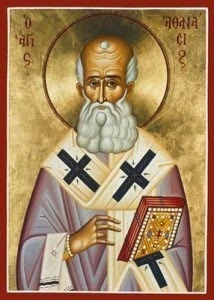 In honor of the feast of the St. Athanasius, I am presenting here an excerpt from an earlier book of mine: not the one with the fish bowls on it, but a book published in 2003, entitled The Created Person and the Mystery of God. Since it doesn't sell many copies these days, I might as well "recycle" some of this interesting material. Various parts of this book were initially drawn up for classroom or other lectures. What is presented here, however, was written for a broad audience.
In honor of the feast of the St. Athanasius, I am presenting here an excerpt from an earlier book of mine: not the one with the fish bowls on it, but a book published in 2003, entitled The Created Person and the Mystery of God. Since it doesn't sell many copies these days, I might as well "recycle" some of this interesting material. Various parts of this book were initially drawn up for classroom or other lectures. What is presented here, however, was written for a broad audience.St. Athanasius shows us that the explicit formulation and development of Catholic doctrine was not a matter of abstract philosophical speculation. It was, rather, an unfolding of the central features of the Gospel. Catholic doctrine protects the saving and transformative word of the Gospel from degenerating into a mere human philosophy. It assures that Jesus present in the Church remains free to approach the human person in the fullness of the truth of who He is and what He wills to give to every human life.
St. Athanasius
The first heresy in Christian history to wield extensive political and social power was a kind of rationalist attack on the Trinity—in particular a denial of the true Divinity of the second person, the Son and Word of the Father. In the center of this storm was the singular figure of St. Athanasius, the celebrated bishop of Alexandria and fearless defender of Trinitarian orthodoxy. The greatness of St. Athanasius was not only his implacable opposition to Arianism in all its forms, but also his insight into the relationship between the mystery of the Trinity and the way in which God truly gives His creatures a share in His own eternal life and glory.
In the first decades of the fourth century, a popular, talented, and politically astute priest in Alexandria named Arius had developed a theory about the Trinity. Up until this time, most attempts by Christian thinkers to shed light on the unity and distinctness of the Father, Son, and Holy Spirit had been provisional at best. For Arius, classical Catholic accounts of the Trinity were dissatisfying and ambiguous and seemed to involve the Church in irrational and contradictory affirmations about God.
He proposed a simple solution, logically coherent, easy to understand, and—at first glance—seemingly consistent with the language of the New Testament: God is one. He is the Unoriginate. The Logos, the Word, is his first and greatest creature. The Word is a reflection of the Divine Being, so perfect that he is called “Son” and God is his “Father” in a unique manner. Nevertheless, he is a creature. According to a famous slogan of Arius which he even set to music, “there was a time when he was not.” This first creature fashioned everything else in turn; therefore he is called “god” in relation to the rest of creation; however he is not divine by nature. The Holy Spirit, too, is a creature, the first and greatest creature of the Word who is himself the divine-like creature of God the Father.
What Arius proposed was ingenious and remarkable, and seemed to give a rationally satisfying explanation of the Trinity. In fact, however, Arius had deconstructed the mystery of the Trinity. After causing some significant controversy especially in Alexandria and the other Eastern churches, and arousing the concern of the Emperor Constantine, Arius’s theory was condemned at the Council of Nicaea in 325, wherein the Only Son of the Father was proclaimed God from God, Light from Light, True God from True God, begotten not made, consubstantial with the Father. After this Council, however, the Arian party succeeded in gaining imperial favor by means of deception and intrigue. Enormous political pressure was brought to bear against orthodox bishops by Constantine’s successors, and imperially sponsored synods tried to construct and then impose compromise Trinitarian formulations that secretly favored the Arian position.
It was under the pressure of the now supposedly Christian (but in fact Arian favoring) Roman political administration that St. Athanasius gave his great personal witness to the Catholic faith. Athanasius was exiled from his see no less than five times during his tumultuous career, because he stubbornly opposed any and every politically engineered compromise with the Arian position. Modern secular historians may often wonder why Athanasius was so passionate and so persistent about what might seem to be an abstract theological point. Yet we can appreciate the energy of his zeal if we realize that he perceived the deep connection between the mystery of the Trinity and the mystery of the Incarnation and Redemption.
Athanasius’s conviction about the Trinity was inseparable from his conviction about the Christian event and its significance for the life of man. Through the incarnation and redemption, God has made it possible for us to share in His very life. Our union with the Word made flesh gives us a participation in the Divine life. This is the great patristic teaching on deification (“theosis”): God became man so that men might become “gods”—that is, adopted sons of the Father.
Athanasius perceived the radical implications of Arius’s theories: if the one who became incarnate in the womb of the Virgin Mary was not fully Divine, how could he possibly give us a participation in the Divine life? In the Arian system, the magnificent destiny of the Christian man comes crashing to the ground. The one who walked the earth, who became our friend, who gave us his flesh to eat and his blood to drink, was merely another creature like us. God has not shown us His face nor invited us into his friendship. He remains a stranger to us.
Thus Athanasius declares: “the Son of God became Son of Man, so that the sons of man, that is, of Adam, might become sons of God. The Word begotten of the Father from on high, inexpressibly, inexplicably, incomprehensibly and eternally, is He that is born in time here below, of the Virgin Mary, the Mother of God, so that those who are in the first place born here below might have a second birth from on high, that is, of God.” Moreover, if the Holy Spirit is not fully God, how can he possibly transform us into the likeness of God? “If the Holy Spirit were a creature, there could be no communion of God with us through Him. On the contrary, we would be joined to a creature, and we would be foreign to the divine nature, as having nothing in common with it…If by participation in the Spirit we are made partakers in the divine nature…it cannot be doubted that His is the nature of God.”
Thus for Athanasius, the full co-eternal divinity of the Word and the Holy Spirit was not only a truth about the mystery of God; it was also a matter of life or death for man—it was a truth decisive for the human vocation. Only the Divine Word made flesh divinizes His brothers and sisters in the flesh. If Christ is anything less than God, then the gates of heaven are closed and man is still in exile from his eternal home. The comfortable rationalism of Arius, in the end, robbed Christianity of its very heart.
Published on May 02, 2014 19:09
May 1, 2014
The Work of Tenderness
 We have already completed one third of the year 2014. It has certainly been an eventful time. Here in America, the flowers of spring are finally blooming after what was for many of us a harsh winter. The coming of spring was a certainty, but many events in the world are developing in ways that we cannot predict.
We have already completed one third of the year 2014. It has certainly been an eventful time. Here in America, the flowers of spring are finally blooming after what was for many of us a harsh winter. The coming of spring was a certainty, but many events in the world are developing in ways that we cannot predict.We continue to watch and pray over the dramas of peoples and nations, and we still wonder what will happen in the coming months at the crossroads of Russia and Ukraine. We wonder what kind of contemporary agendas may be clashing in the midst of this ancient fraternal quarrel, and what it might mean for the West, the United States, our children.... Certainly we have hope that peace will prevail. No one wants to imitate the inexorable march to catastrophe of our ancestors a hundred years ago. No one wants to learn by experience the strange, unforeseeable cruelties of global warfare in a new century. We have enough brutality among ourselves as it is. We have enough need to take responsibility for our own families and communities, to turn to God and to one another, to build up the good, to help one another, to bring healing to the broken, strength to the weak, protection to the vulnerable.
We don't need war. We are already living in the midst of war. We need to become peacemakers, builders of human places in our own communities.
May day is observed as Labor Day in many countries around the world, and the Church marks this day as a feast for St. Joseph the Worker. Every human being is called to be a worker; we are called to engage in the circumstances of our daily lives, called to work in mostly humble ways so that goodness and beauty might flourish and grow. If we give our hearts to God, He will work through us so that we can bring to our fragile human world a much needed tenderness.
In speaking about St. Joseph and his work, Pope Francis emphasized this special quality, and we must beg God to make us tender toward one another and our world if we are to hope for peace:
"Saint Joseph appears as a strong and courageous man, a working man, yet in his heart we see great tenderness, which is not the virtue of the weak but rather a sign of strength of spirit and a capacity for concern, for compassion, for genuine openness to others, for love. We must not be afraid of goodness, of tenderness!" (Pope Francis, March 19, 2013)
Published on May 01, 2014 17:44
April 30, 2014
I Throw Myself Upon His Infinite Mercy
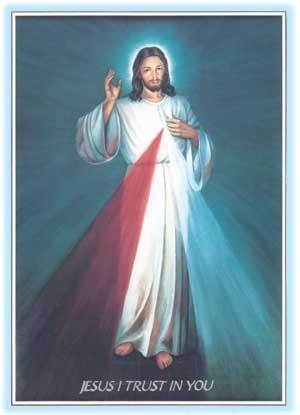 All the events of last week were set within the context of our annual Divine Mercy novena and the celebration of Mercy Sunday. Having journeyed through Lent and the Paschal Triduum, we culminate with the celebration of God's mercy. (Another thing for which we can thank St. John Paul II).
All the events of last week were set within the context of our annual Divine Mercy novena and the celebration of Mercy Sunday. Having journeyed through Lent and the Paschal Triduum, we culminate with the celebration of God's mercy. (Another thing for which we can thank St. John Paul II).The mercy of God in Jesus Christ is where I find my roots. I don't know where else to stand. Mercy is the creative, forgiving, regenerating love of God beyond all measure. Mercy is the love that gives us what we lack, that empowers us to accomplish what we can't do by ourselves.
Mercy is where I must go, because I am a complete mess as a human being. I'm not happy about that. I want to change (although, frankly, I'm often glad to just be lazy). My love for God is weak. My desire to grow in love is weak. What do I have, really, that I can bring before God in prayer.
Jesus. Every day I pray, "Lord, I throw myself upon your infinite mercy!" After all is said and done, and I find my work and my prayer to be a sorry mixed bag, what's left? Jesus.
God gives Himself. He is the way and the truth and the life. He is my hope for healing and for attaining my destiny. Jesus gives Himself to save me from my sins, and also to give me a participation in the life of God. The life of God! Whoever even thinks about this? Whoever thinks about the fact that Jesus brings not only freedom from sin but also a radical elevation of life to the level of union with God?
Here I am, struggling day by day just to get by, to survive, to tread water in the ocean of my own sanity. And yet I am called to live forever with God. It's difficult even to understand what this means. Do I even want this, really? Yes, I have been created to want this, and yet I live on the surface of myself. I don't know what to do in the end except to throw myself upon the mercy of God.
And this "God" for whom I have been created: who is He? Who is God?
Infinite Giving, Infinite Giftedness and Giving, Infinitely Poured Out: Infinitely, Eternally, Transcending all possible created worlds of limitation and definition such as we have ever known or have ever experienced.
All these words of mine are baby talk; I aim sounds of speech and fall so short. Poor words.
God Is, and God Is Love.
The very inner life of God is love. The One God is a Trinity of Persons. God has revealed Himself as Father, Son, and Holy Spirit.
Let us allow our beloved Emeritus Pope Benedict XVI to help us adore this mystery:
"Three Persons who are one God because the Father is love, the Son is love, the Spirit is love. God is wholly and only love, the purest, infinite and eternal love. He does not live in splendid solitude but rather is an inexhaustible source of life that is ceaselessly given and communicated" (General Audience for Trinity Sunday, 2009).
Published on April 30, 2014 20:05
April 29, 2014
The Janaro Family Goes to Washington
 Heading to the big cityI promised a post and more pictures from our family fun day in Washington, D.C. last week, and with good reason. It was fun! Not like hold-on-to-the-edge-of-your-seats kind of fun. It was a day of being together and sharing in a little adventure.
Heading to the big cityI promised a post and more pictures from our family fun day in Washington, D.C. last week, and with good reason. It was fun! Not like hold-on-to-the-edge-of-your-seats kind of fun. It was a day of being together and sharing in a little adventure.I went to school in Washington, D.C. I worked there. I lived in the D.C. area. All of that was more than 20 years ago. I can't think of a time when the whole Janaro family -- all seven of us -- went into the city. All we did was go to a couple of museums and hang around the Mall (not a shopping mall, but the long park between the Washington Monument and the Capital Building).
I also grew up in cities, whereas my kids are small town and country born and raised. Which means that they are thrilled and amazed in ways that I will never understand, by activities such as riding the Metro.
 "Wow, this is incredible!"
"Wow, this is incredible!"
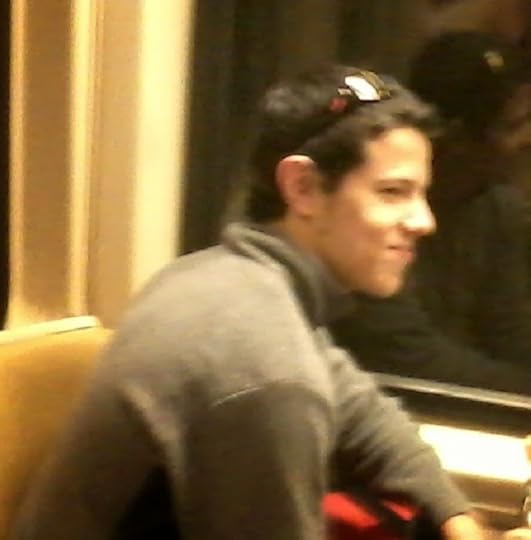 John Paul is veteran Metro rider, having gone to Nats & Caps games, but he still likes it.
John Paul is veteran Metro rider, having gone to Nats & Caps games, but he still likes it.
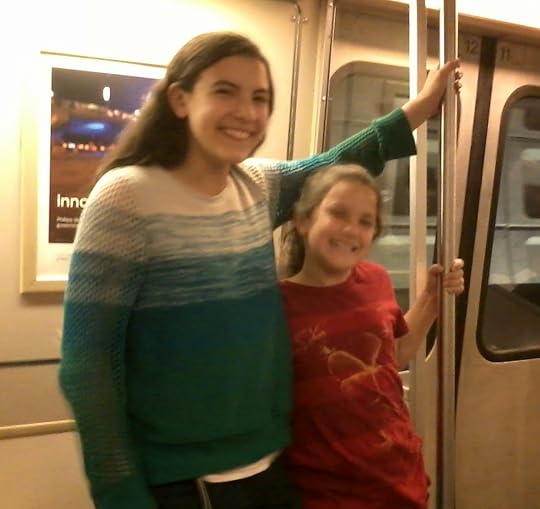 Agnese and Teresa: there were plenty of seats but they wanted to stand just for fun!
Agnese and Teresa: there were plenty of seats but they wanted to stand just for fun!
 Lucia looks cool, but if you can see her dimples you know she's having fun.
Lucia looks cool, but if you can see her dimples you know she's having fun.We got off at the "Smithsonian" station, had our lunch and goofed around a little. The Mall has a leisurely feel to it, even in the middle of the week. It doesn't feel like you're in the capital city of the most powerful nation in human history.
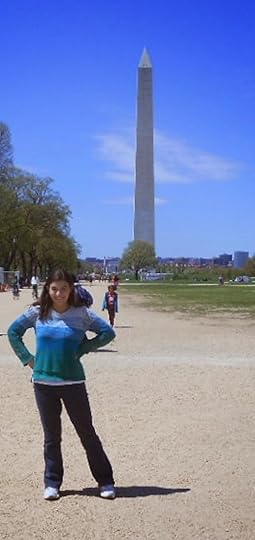 Agnese and the Washington Monument: Are we tourists or what?
Agnese and the Washington Monument: Are we tourists or what?
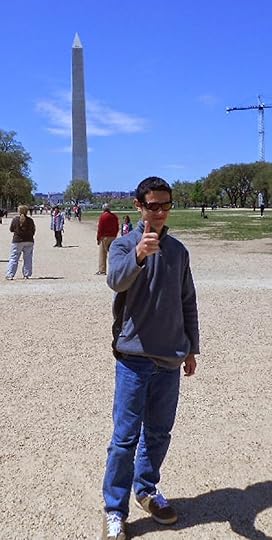 John Paul is cool.
John Paul is cool.
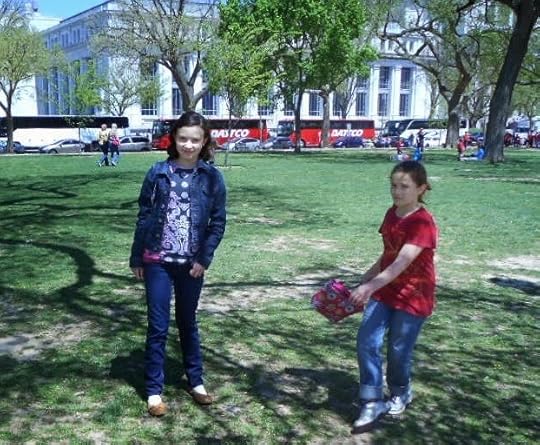 "Can we just have the picnic now, please?"
"Can we just have the picnic now, please?"Okay, we eat and then we're off to the sculpture garden and the art museum. The sculpture garden is, well, interesting, with things like this metal tree:
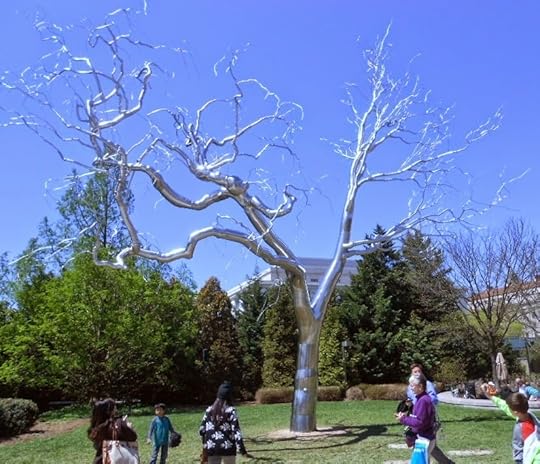 If this ever blossoms, it really will be time for "the return of the king"!
If this ever blossoms, it really will be time for "the return of the king"!
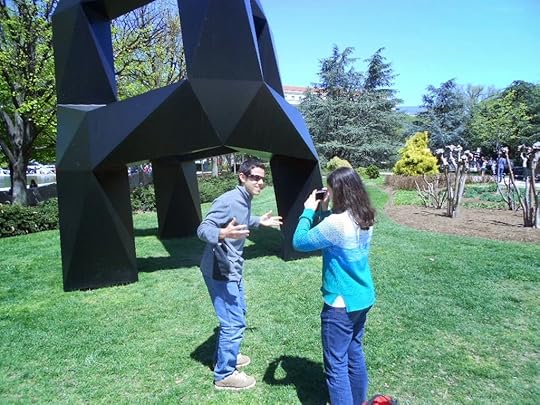 John Paul explains the deep existential significance of this... umm... thingy.
John Paul explains the deep existential significance of this... umm... thingy.
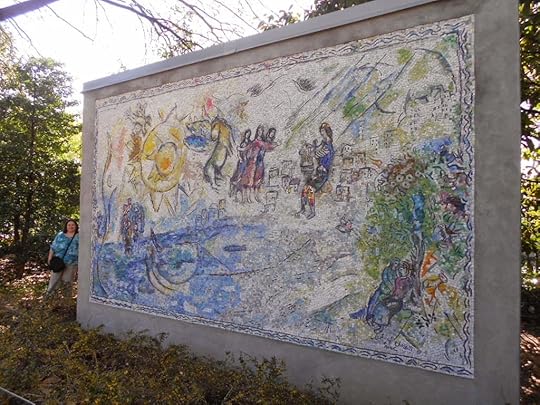 Eileen at the Chagall mosaic, which is amazing (much better than this photo).
Eileen at the Chagall mosaic, which is amazing (much better than this photo).Inside the National Gallery of Art, we went through the regular (and quite remarkable) collection, and we were allowed to take pictures. So I took hundreds of pictures with my phone. It used to be, strictly, no pictures, but now you just click away. Phone pictures are not that great, but it's fun just setting them up, looking at the work from different angles, discovering details. And of course, sometimes you just stop and look.
Pictures of a few works that I might not have otherwise noticed, such as:
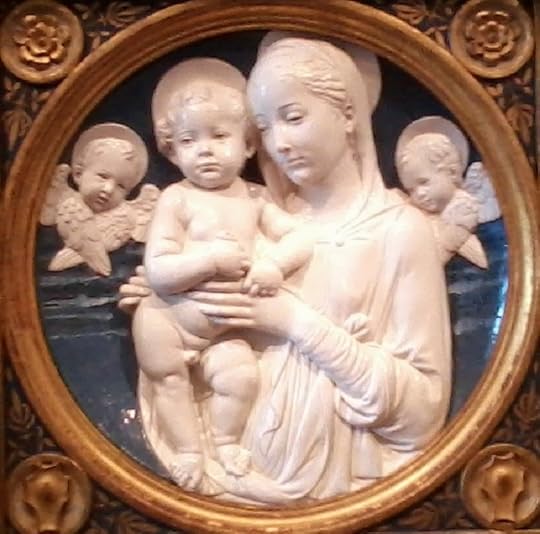
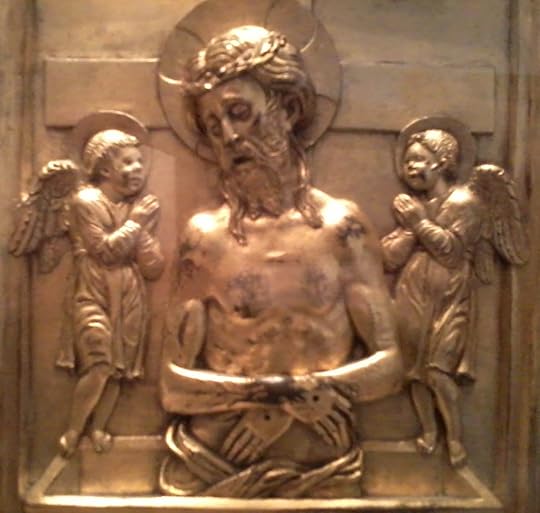
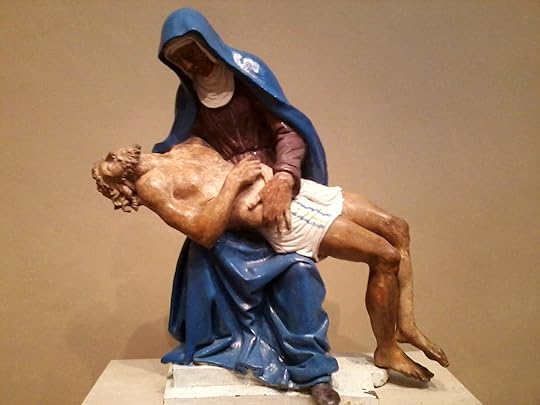
And many other beautiful works. We spent a lot of time on our feet, but there are plenty of lovely and atmospheric places in the Gallery to rest also:
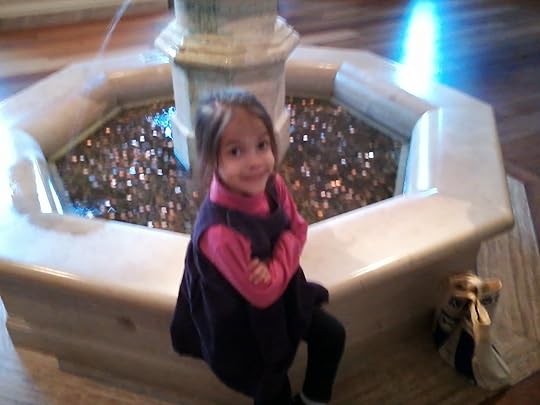 Josefina relaxes by a fountain.
Josefina relaxes by a fountain.Then it was off to the Museum of Natural History. We didn't have too much time here (and by then I was out of gas, so I spent most of that time on a bench), but we did get to see THE DINOSAURS. Just in time too: this whole section is closed as of this week for renovations that will take several years.
Josefina thought the dinosaurs were creepy. It took some cajoling to get her to stand in front of one so I could take a picture. She enjoyed the smaller exhibits like the fossils:
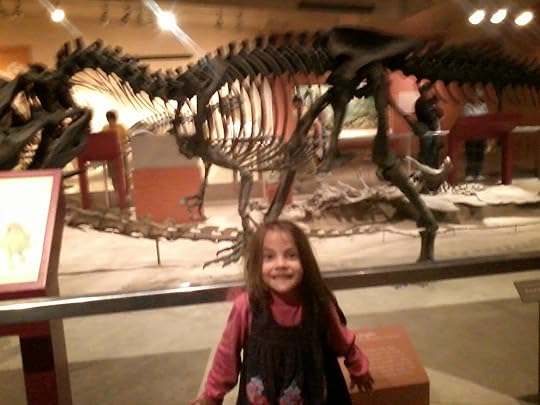 "AHHHH! Do I have to smile?"
"AHHHH! Do I have to smile?"
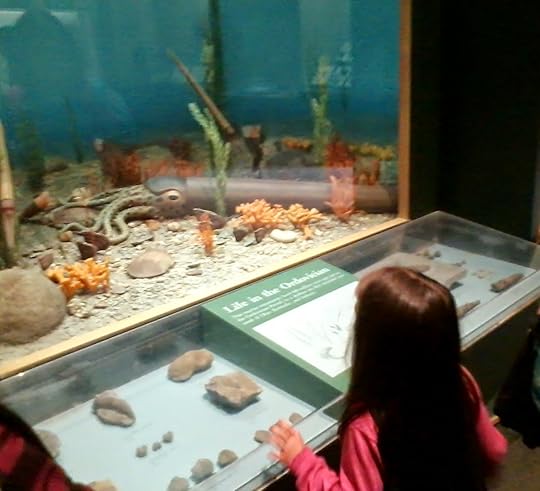 Prehistoric sea is more in the comfort zone. "Is that real?"
Prehistoric sea is more in the comfort zone. "Is that real?"I realize that unless you are the grandparents of these children (Hi Dad, hi Mom!) you're bored by now, so it's time for us to go home:
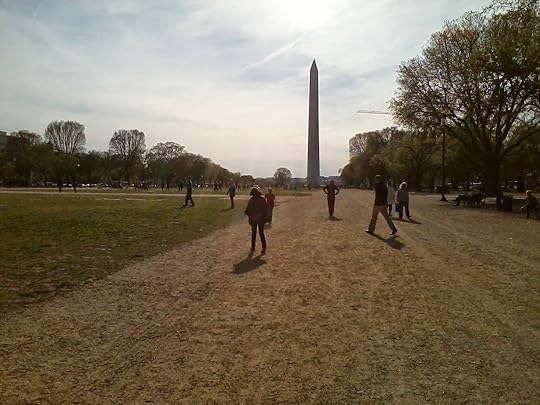 Back out to the Mall. Clouds in the late afternoon.
Back out to the Mall. Clouds in the late afternoon.
 Escalators are fun too!
Escalators are fun too!I highly recommend doing lightly planned little trips with the family. Don't try to do too much and don't have huge expectations, but just enjoy what's there and enjoy being together. It's worth it.
Published on April 29, 2014 20:17



